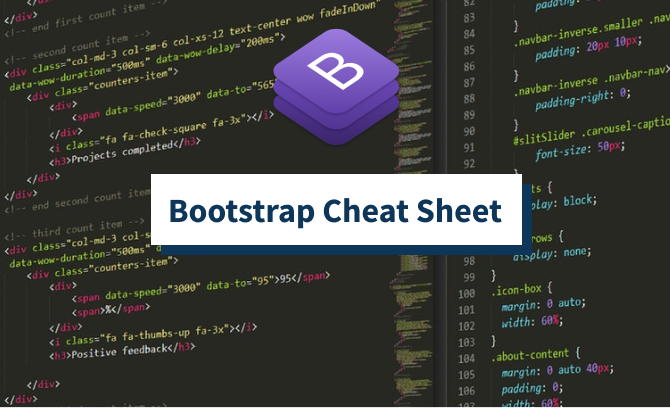Bootstrap 5 is the newest version of the popular front-end framework. It includes a number of new features and improvements over previous versions. In this article, we’ll provide a Bootstrap 5 cheatsheet that covers all of the new features and changes.
This will be an essential resource for anyone who wants to quickly learn about the new version or just refresh their knowledge.
Are you looking for a Bootstrap 5 cheatsheet? Well, look no further! This article will provide you with all the necessary information to get started with Bootstrap 5.
Bootstrap 5 is the latest version of the popular front-end framework. It includes new features and improvements over its predecessor, Bootstrap 4. Some of the highlights of Bootstrap 5 include:
– A new grid system that is responsive by default
– Updated form controls and validation styles
– Improved accessibility support
– Support for RTL (right-to-left) languages
– And much more!
Bootstrap 4/5 cheat sheet | HTML and CSS | quick templates
How Many Classes are There in Bootstrap 5?
Bootstrap 5 is still in alpha, so there are bound to be changes before the final release. However, according to the current documentation, there are five classes in Bootstrap 5: .container, .
row, .col, .d-* (display), and .
flex-* (flexbox).
How Do I Download Bootstrap 5 Documents Offline?
If you want to download Bootstrap 5 offline, there are a few options available to you. One is to download the Bootstrap 5 source files from GitHub. Another option is to use a package manager like npm or yarn to install Bootstrap 5.
If you choose to download the Bootstrap 5 source files, you will need to unzip the file and then open the index.html file in a web browser. This will give you access to all of the documentation for Bootstrap 5. If you want to be able to view the documentation offline, you can use a tool like MAMP or XAMPP to run a local web server on your computer.
If you choose to use a package manager like npm or yarn, you can install Bootstrap 5 with the following command:
npm install bootstrap@5.0.0-alpha1
or
Why Use Bootstrap?
Bootstrap is a free and open-source CSS framework directed at responsive, mobile-first front-end web development. It contains CSS – and JavaScript-based design templates for typography, forms, buttons, navigation and other interface components.
Bootstrap is the most popular HTML, CSS, and JS framework for developing responsive, mobile first projects on the web.
Bootstrap makes front-end web development faster and easier. It’s made for folks of all skill levels, devices of all shapes, and projects of all sizes.
Here are some reasons to use Bootstrap:
1. Speed up your development time
2. Develop responsive websites
3. Consistent look-and-feel across multiple browsers
Using Bootstrap can save you a lot of time when you’re building websites. You don’t have to worry about cross browser compatibility issues because Bootstrap takes care of that for you. And since it’s responsive by default, your website will look great on any device without having to write additional code or media queries.
.
Which of the Following are Valid Bootstrap Button Classes?
There are multiple classes that can be applied to bootstrap buttons to achieve different styles. Some of the more commonly used classes are:
“btn-default” – this is the basic button style that is applied by default if no other class is specified
“btn-primary” – this gives the button a dark blue/purple color scheme
“btn-success” – this gives the button a green color scheme, typically signifying success or positive actions
“btn-info” – this gives the button a light blue color scheme, typically used for informational purposes

Credit: websitesetup.org
Bootstrap 5 Cheat Sheet Pdf
Bootstrap 5 is the upcoming version of the popular front-end framework. Bootstrap 5 includes a number of new features and improvements, including support for CSS3 Grids, a new responsive navbar, better form validation, and more.
The Bootstrap 5 Cheat Sheet PDF provides a quick reference guide for all the new features and changes in the latest version of Bootstrap.
This cheat sheet is a handy resource for both experienced developers and newcomers to the framework.
Conclusion
Bootstrap 5 has finally arrived! This popular front-end framework has been updated to include a number of new features and improvements, including improved support for Flexbox, a new grid system, better form validation, and more.
If you’re unfamiliar with Bootstrap, it’s a CSS framework that provides pre-built styles and components that can be used to quickly build responsive websites.
Bootstrap is one of the most popular front-end frameworks in use today, so if you’re looking to get started with responsive web development, this cheatsheet is a great place to start.
Here are some of the highlights of the new features in Bootstrap 5:
Improved support for Flexbox: Bootstrap 5 now includes improved support for Flexbox, making it easier to create responsive layouts.
New grid system: A new grid system has been introduced in Bootstrap 5 that makes it easier to create responsive layouts. The new grid system is based on a 12-column layout, which can be nested and combined as needed.
Better form validation: Form validation has been improved in Bootstrap 5, making it easier to ensure that your forms are validating correctly.

Leave a Reply